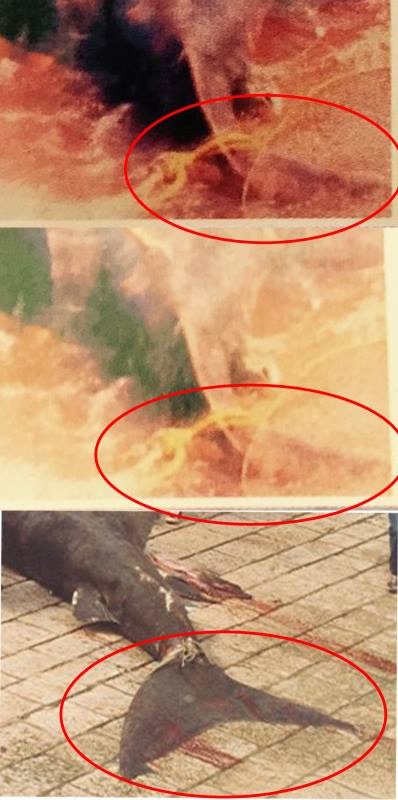Update: Mystery Creature Carcass Identified?
Posted by: Markus Hemmler on September 14th, 2015
Commentary and additional information regarding this Cryptomundo post by Dr. Karl Shuker: Mystery Creature Carcass Identified?
As this happened in the 1980s, I’m pretty sure that some scientific paper or database includes this incident together with the identification as basking shark (Cetorhinus maximus). Following Karl Shuker’s question re the identification I’ve done some comparisons showing clearly that its another pseudoplesiosaur:
The “Ogopogo” carcass from “In search of Ogopogo”, Part 1: Comparision with the pectoral, dorsal and pelvic fin as well as the caudal keel of a basking shark. Clear match.

The “Ogopogo” carcass from “In search of Ogopogo”, Part 2: Comparision with the pectoral fin and inside of the lower jaw/mouth of a basking shark. Clear match.

The “Ogopogo” carcass from “In search of Ogopogo”, Part 3: Comparision of the heterocercal caudal fin of a basking shark and the caudal keel typical of lamniforms. Clear match.

Let me add some explanations: In general it’s obviously a larger marine creature, so I considered larger known, recent marine creatures (namely cetacean or sharks) at first for identification and not a sturgeon as suggested.
Behind the yellow rope an part of the caudal fin can be seen in the water. As we can conclude from those other anatomical features explained later (positon of fins, head) the carcass is lying on its right side, what means that this is a heterocercal caudal fin and therefore immediately excludes any cetacean. But the “three-foot-long ridge running from the front of the tail onto the back end” is corresponding with the typical tail keel of lamniform sharks like Cetorhinus.
Following the tail, the first “appendage” on the underside corresponds to the pelvic fin of a shark. On the opposing side, not far from this fin in anterior direction, another fin can hardly be seen in the water. This obviously larger fin is corresponding with the position of a shark’s dorsal fin. Shortly before the “neck”, on its underside again, is another fin which corresponds with the pectoral fin of a shark.
The pectoral fin from another angle again in the third pic; in relation it is a larger fin than for example the pelvic one. The head seems oval, whitish and bent inward like a spoon; a black coloured part inside is visible. The spoon-shape indicates that we see the inside of a mouth; the upper part of the head is located in the water and therefore can’t be seen. These observations together correspond to the inner side of a basking shark’s lower jaw (be aware that the individual used for comparison is somewhat smaller, so it’s not the exact same shape) whose branchial arches leave open space corresponding to the black coloured part. Considering the basking shark identity explains also why no teeth are visible, as these species teeth are very tiny.
The dark coloration of the carcass with the whitish/pinkish colour pattern is adding to the same coloration we know from basking sharks.
As widely known this species is behind many cases of dead “sea monsters” due to their unique morphology and taphonomy. Those other carcasses mentioned in the book of Prince Rupert (1934) and 1947 (Effingham Island) have been identified as Cetorhinus maximus too.
About Markus Hemmler
German cryptozoologist who specializes in globsters.










Interesting indeed. I guess my first question is:
Is there a history of basking sharks in Lake Okanagan? It doesn’t have an outlet to the ocean does it? Or does it? (No, I haven’t taken the time to google it–that’s what’s called inviting a discussion :))
Well… the lake is connected to the Okanogan River which enters the Columbia River which emptying into the Pacific Ocean. So yes, there’s a connection. 😉 Arlene used this photos to question if a subspecies of giant sturgeons exist, which maybe she links to Ogopogo. But I haven’t read the book and I don’t will do due to a lack of interest.
I believe that Okanagan Lake connects to Skaha Lake via a man made channel built in the 1950s. Skaha Lake then drains into the Okanagan River.
The original article’s caption state that the unknown’s images were taken at the Caspe’ Peninsula which is on the Eastern side of Canada. Ogopogo is reported from Lake Okanagan which is in British Columbia, in Western Canada…
Thanks, Insanity…but it still begs the question…are there basking sharks that have been reported in Okanagan???
Thanks CK.
Well now I’m gonna have to go read Arlene Gaul’s book to find out what the heck the connection is between Ogo and this thing . . .if any.